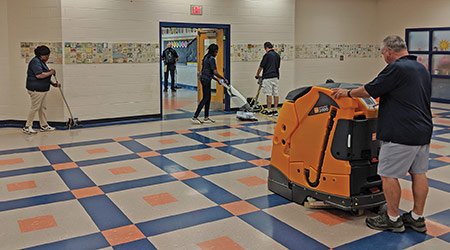
Once few and far between, cleaning robots are becoming more commonplace in the building service contractor's arsenal of equipment. In fact, a growing number of BSC customers are asking for — and in some cases demanding — the use of robotics in their requests for proposal.
Superior Solutions Group at GDI Integrated Facility Services, Edmonton, Alberta, Canada, started exploring the use of robots three years ago. Today, the BSC has about 10 robots deployed in office buildings, shopping centers, colleges and universities.
"Our business is becoming more commoditized, so in order to survive you have to drive innovation and use technology to improve performance and the quality of the cleaning outcome," says CEO Craig Rudin.
Like Superior Solutions, more contract cleaners are turning to robots in response to rising labor costs as well as the challenges of finding and retaining employees. But BSCs are quick to point out that these machines will never replace humans.
"[The janitor's] biggest fear is that robots will come in and take their jobs," says Pat Manuel, co-founder of LaserClean Systems, Richmond, Virginia. "But that couldn't be further from the truth. So we need to help them understand the value they can gain from them and how to work alongside the technology."
For instance, robots can tackle monotonous work, such as cleaning floors, which frees up janitors to do detail work and intuitive cleaning tasks as well as interact with clients.
Kimberly Train is director of platform services at Oxford Properties, Toronto, Ontario, Canada, the real estate investment arm of OMERS, one of Canada's largest pension plans with management of assets across Canada, the United States and Europe. She has seen tremendous productivity gains as a result of reassigning janitors to perform highly valued detail work in place of spending an entire shift operating ride-on autoscrubbers. In fact, the company now requires the use of robotic floor scrubbers in all of its cleaning contracts for mall common areas and food courts, and is expanding the use of robots to office environments with substantial lobbies and common areas.
Prior to mandating the use of autonomous cleaning equipment, Oxford Properties purchased its own robot for a 50,000-square-foot expansion at one of its shopping centers cleaned by an in-house crew. When launched, the robot cleaned approximately 12,000 square feet an hour. Thanks to new software developments, it now covers about 60,000 square feet a night in about 4.5 hours on one battery charge. The robot has become an integral support tool for the existing team at Oxford Properties.
"The cleaning companies that will succeed are those that integrate robots into their workforce so the team doesn't see them as a threat but rather as another tool for them to produce the best outcomes," says Train.
Automation An Asset To Janitor

 Celebrating BSCAI's 60th Anniversary eBook
Celebrating BSCAI's 60th Anniversary eBook The Down and Dirty on Cleaning in Virus Season
The Down and Dirty on Cleaning in Virus Season How Surfactant Use is Expanding in Commercial Cleaning
How Surfactant Use is Expanding in Commercial Cleaning